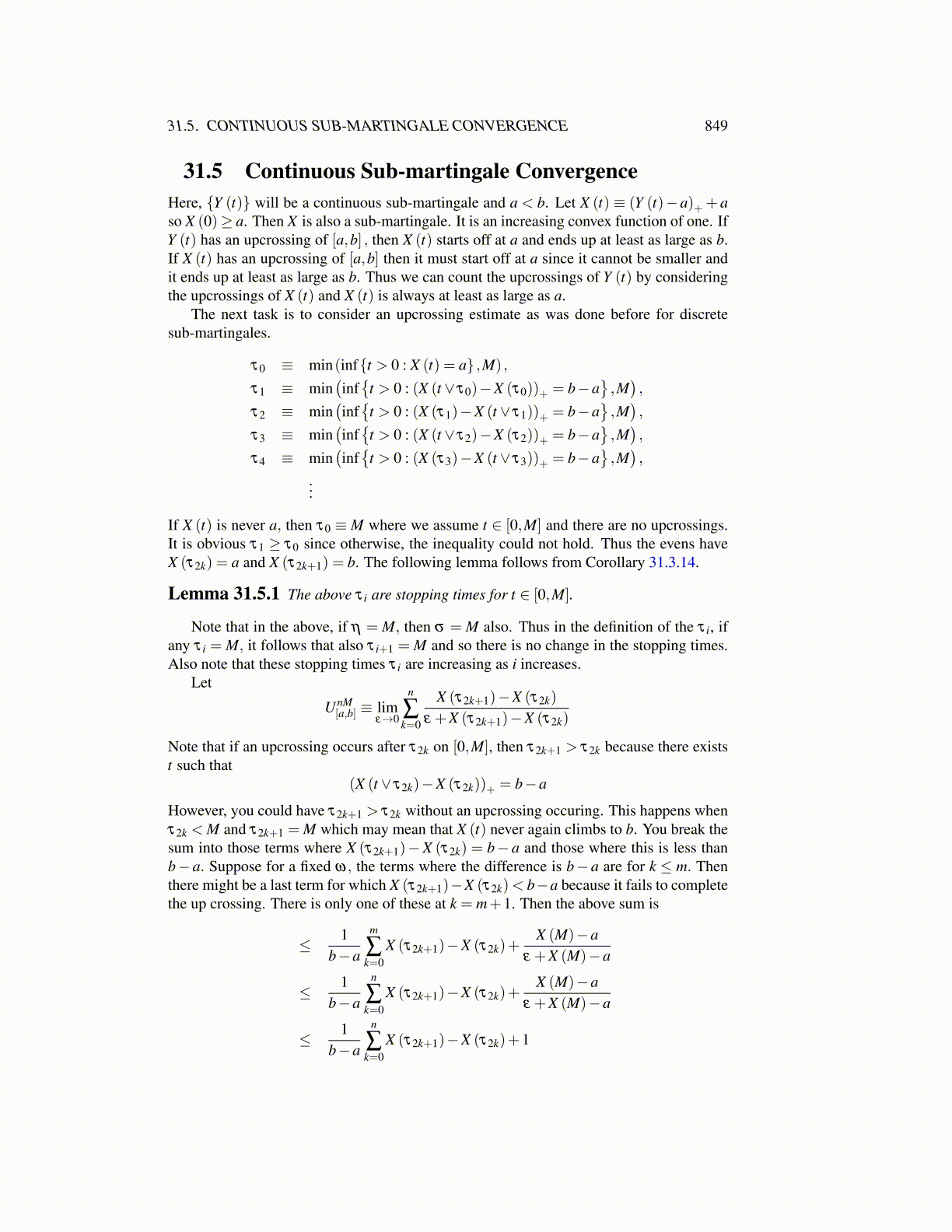
31.5. CONTINUOUS SUB-MARTINGALE CONVERGENCE 849
31.5 Continuous Sub-martingale ConvergenceHere, {Y (t)} will be a continuous sub-martingale and a < b. Let X (t) ≡ (Y (t)−a)++aso X (0)≥ a. Then X is also a sub-martingale. It is an increasing convex function of one. IfY (t) has an upcrossing of [a,b] , then X (t) starts off at a and ends up at least as large as b.If X (t) has an upcrossing of [a,b] then it must start off at a since it cannot be smaller andit ends up at least as large as b. Thus we can count the upcrossings of Y (t) by consideringthe upcrossings of X (t) and X (t) is always at least as large as a.
The next task is to consider an upcrossing estimate as was done before for discretesub-martingales.
τ0 ≡ min(inf{t > 0 : X (t) = a} ,M) ,
τ1 ≡ min(inf{
t > 0 : (X (t ∨ τ0)−X (τ0))+ = b−a},M),
τ2 ≡ min(inf{
t > 0 : (X (τ1)−X (t ∨ τ1))+ = b−a},M),
τ3 ≡ min(inf{
t > 0 : (X (t ∨ τ2)−X (τ2))+ = b−a},M),
τ4 ≡ min(inf{
t > 0 : (X (τ3)−X (t ∨ τ3))+ = b−a},M),
...
If X (t) is never a, then τ0 ≡M where we assume t ∈ [0,M] and there are no upcrossings.It is obvious τ1 ≥ τ0 since otherwise, the inequality could not hold. Thus the evens haveX (τ2k) = a and X (τ2k+1) = b. The following lemma follows from Corollary 31.3.14.
Lemma 31.5.1 The above τ i are stopping times for t ∈ [0,M].
Note that in the above, if η = M, then σ = M also. Thus in the definition of the τ i, ifany τ i = M, it follows that also τ i+1 = M and so there is no change in the stopping times.Also note that these stopping times τ i are increasing as i increases.
Let
UnM[a,b] ≡ lim
ε→0
n
∑k=0
X (τ2k+1)−X (τ2k)
ε +X (τ2k+1)−X (τ2k)
Note that if an upcrossing occurs after τ2k on [0,M], then τ2k+1 > τ2k because there existst such that
(X (t ∨ τ2k)−X (τ2k))+ = b−a
However, you could have τ2k+1 > τ2k without an upcrossing occuring. This happens whenτ2k < M and τ2k+1 = M which may mean that X (t) never again climbs to b. You break thesum into those terms where X (τ2k+1)−X (τ2k) = b− a and those where this is less thanb− a. Suppose for a fixed ω, the terms where the difference is b− a are for k ≤ m. Thenthere might be a last term for which X (τ2k+1)−X (τ2k)< b−a because it fails to completethe up crossing. There is only one of these at k = m+1. Then the above sum is
≤ 1b−a
m
∑k=0
X (τ2k+1)−X (τ2k)+X (M)−a
ε +X (M)−a
≤ 1b−a
n
∑k=0
X (τ2k+1)−X (τ2k)+X (M)−a
ε +X (M)−a
≤ 1b−a
n
∑k=0
X (τ2k+1)−X (τ2k)+1